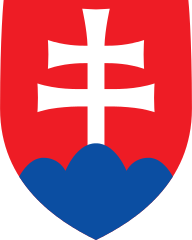(Dark-Green) Slovakia
(Light-Green) The rest of the European Union (EU)
(Dark-grey) The rest of Europe
(Light-grey) The surrounding region
Slovakia
Slovakia (/sloʊˈvækiə, slə-, –ˈvɑː-/ (![]() listen); Slovak: Slovensko [ˈsloʋensko] (
listen); Slovak: Slovensko [ˈsloʋensko] (![]()
![]()
![]()
![]()
![]()
![]()
![]()
![]()
The Slavs arrived in the territory of present-day Slovakia in the 5th and 6th centuries. In the 7th century, they played a significant role in the creation of Samo’s Empire and in the 9th century established the Principality of Nitra. In the 10th century, the territory was integrated into the Kingdom of Hungary. After World War I and the dissolution of the Austro-Hungarian Empire, the Slovaks and Czechs established Czechoslovakia. A separate (First) Slovak Republic (1939–1945) existed in World War II as a client state of Nazi Germany. In 1945, Czechoslovakia was re-established and under Communist rule became Soviet satellite. In 1989, the Velvet Revolution ended Communist rule in Czechoslovakia. Slovakia became an independent state on 1 January 1993 after the peaceful dissolution of Czechoslovakia, sometimes known as the Velvet Divorce.
Slovakia is a high-income advanced economy with a very high Human Development Index, a very high standard of living and performs favourably in measurements of civil liberties, press freedom, internet freedom, democratic governance and peacefulness. The country maintains a combination of market economy with a comprehensive social security system. Citizens of Slovakia are provided with universal health care, free education and one of the longest paid maternity leave in the OECD. The country joined the European Union in 2004 and the Eurozone on 1 January 2009. Slovakia is also a member of the Schengen Area, NATO, the United Nations, the OECD, the WTO, CERN, the OSCE, the Council of Europe and the Visegrád Group. The Slovak economy is one of the fastest growing economies in Europe and 3rd fastest in eurozone. Its legal tender, the Euro, is the world’s 2nd most traded currency. Although regional income inequality is high, 90% of citizens own their homes. In 2016, Slovak citizens had visa-free or visa-on-arrival access to 165 countries and territories, ranking the Slovak passport 11th in the world. Slovakia is the world’s largest per-capita car producer with a total of 1,040,000 cars manufactured in the country in 2016 alone and the 7th largest car producer in the European Union. The car industry represents 43% of Slovakia’s industrial output, and a quarter of its exports.
Flag of Slovakia
National Anthem of Slovakia
Education in Slovakia
Most schools, especially universities, are owned by the state, though since the 1990s there are also church-owned and private schools. Slovakia has 10 years of compulsory education. Students go to school five days a week, from Monday until Friday…
CULTURE OF SLOVAKIA


Folk tradition has rooted strongly in Slovakia and is reflected in literature, music, dance and architecture…

